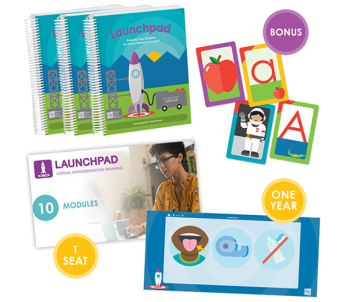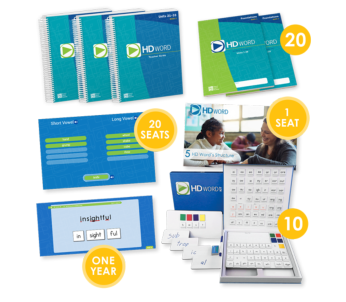Blast™ for 1st Grade
Blast Off to Reading Mastery
Blast accelerates first-grade reading development with targeted, systematic instruction. Through engaging, research-backed, multi-sensory lessons, the program builds decoding skills, fluency, and confidence in young readers.
Blast’s structured lessons and interactive activities help first graders develop critical reading skills, including strong decoding, fluency with high-frequency words, and strategies for tackling new words. The program also includes Really Great Handwriting to refine print skills, with minimal prep time and built-in professional development for teachers.
Teacher Guide

- Scripted, ready-to-teach lesson plans
- Thorough explanation of concepts, routines, and procedures
- Options for adjusting and differentiating instruction
- Embedded, incremental professional development—no phonological awareness or phonics background needed!
- Includes lesson plan books, vowel posters, student workbooks and kits
Blast Online

Blast Online reduces prep time while enhancing instructional precision.
- Dynamic, image-based presentation tool that boosts classroom engagement and learning
- Delivers clear, effective instruction with vibrant visuals and real-time interactive features
- Compatible with interactive whiteboards, projectors, tablets, laptops, and computers
- BONUS: Access a library of activities, supplements, and professional development resources through The Supply Room
Virtual Implementation Training Courses

Virtual Training for Educators
Unlock Blast’s full potential with interactive, self-paced training. The implementation training is designed to fit seamlessly into educators' busy schedules, regardless of their prior knowledge of the Science of Reading. With its interactive and virtual format, it ensures a confident and powerful start with Blast, helping educators feel fully prepared for success.
Reading Playground

The Reading Playground helps students independently practice foundational literacy skills and complements Countdown by offering additional reinforcement opportunities. This fun, interactive tool features a variety of assessment options—formative assessments, progress monitoring, diagnostics, and program assessments—along with comprehensive reporting capabilities that let teachers pinpoint students’ strengths and areas for improvement.
- Accessible Across Devices: Responsive capabilities for use on various platforms
- Teacher Dashboard: Easy-to-read interface for managing assignments, receiving targeted activity recommendations, and accessing detailed reports and helpful resources—all in one place
- Spanish Support: Instructions in English and Spanish for better understanding, accurate progress tracking, and documentation of language accommodations
- Vocabulary Playgrounds: Reinforce phonology, orthography, morphology, and meaning of words

- Scripted, ready-to-teach lesson plans
- Thorough explanation of concepts, routines, and procedures
- Options for adjusting and differentiating instruction
- Embedded, incremental professional development—no phonological awareness or phonics background needed!
- Includes lesson plan books, vowel posters, student workbooks and kits

Blast Online reduces prep time while enhancing instructional precision.
- Dynamic, image-based presentation tool that boosts classroom engagement and learning
- Delivers clear, effective instruction with vibrant visuals and real-time interactive features
- Compatible with interactive whiteboards, projectors, tablets, laptops, and computers
- BONUS: Access a library of activities, supplements, and professional development resources through The Supply Room

Virtual Training for Educators
Unlock Blast’s full potential with interactive, self-paced training. The implementation training is designed to fit seamlessly into educators' busy schedules, regardless of their prior knowledge of the Science of Reading. With its interactive and virtual format, it ensures a confident and powerful start with Blast, helping educators feel fully prepared for success.

The Reading Playground helps students independently practice foundational literacy skills and complements Countdown by offering additional reinforcement opportunities. This fun, interactive tool features a variety of assessment options—formative assessments, progress monitoring, diagnostics, and program assessments—along with comprehensive reporting capabilities that let teachers pinpoint students’ strengths and areas for improvement.
- Accessible Across Devices: Responsive capabilities for use on various platforms
- Teacher Dashboard: Easy-to-read interface for managing assignments, receiving targeted activity recommendations, and accessing detailed reports and helpful resources—all in one place
- Spanish Support: Instructions in English and Spanish for better understanding, accurate progress tracking, and documentation of language accommodations
- Vocabulary Playgrounds: Reinforce phonology, orthography, morphology, and meaning of words
Builds decoding skills through targeted, sequential lessons, cultivating a growth mindset for every learner.
The program’s Reading Playground, a play-based, digital platform, offers individualized practice and reinforces concepts and skills taught through teacher-led instruction.
Covers foundational skills through a cumulative approach, while data and reporting inform instruction and highlight students’ areas of improvement.
Hands-on kits with visual and auditory supports engage students fully.
Easy-to-teach lessons and digital tools minimize preparation and streamline instruction.
Embedded professional learning ensures teachers feel prepared and develops their capacity.




